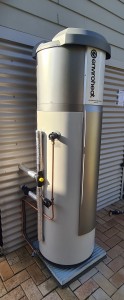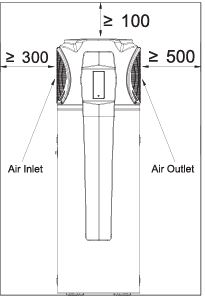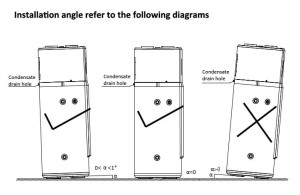Air-source heat pumps work on ambient air temperature and require adequate ventilation. Therefore installation in an enclosed space is not recommended. They need to be positioned externally in the fresh air to ensure adequate airflow around the unit for optimal operation.  Proper ventilation is crucial for heat pump units to function efficiently. A heat pumps performance changes with ambient air temperature, humidity and incoming water temperature. They can produce they can produce two to three times more heat output than they consume in electricity input making them up to 71% more efficient than standard electric water heaters.
Proper ventilation is crucial for heat pump units to function efficiently. A heat pumps performance changes with ambient air temperature, humidity and incoming water temperature. They can produce they can produce two to three times more heat output than they consume in electricity input making them up to 71% more efficient than standard electric water heaters.
Choosing the right installation location
Installation externally in the open air is the best location for a heat pump installation. Installing under the house eaves or in a sheltered but unenclosed environment will help to protect it from the elements and potentially prolong the life of the system. Ensure there are no obstructions like trees or shrubs that may block airflow. The modern heat pumps are now relatively quiet, however they do still generate some noise and therefore it is best to install away from the bedrooms. Some heat pumps now have built in timers to allow you to run them during the day rather than at night.
Minimum clearances
The units must must be installed with sufficient clearances to allow airflow to circulate through the unit. An example of a particular manufacturers clearance requirements are 300mm on the air inlet side, 500mm on the air outlet side and 100mm overhead and rear clearance. This is an example of one manufacturer only and clearance minimums will be subject to your specific manufacturer’s technical specifications. Without sufficient airflow, discharged cold air will recirculate into the unit and lower the heating efficiency or cause potential compressor failure. Incorrect airflow clearances will potentially void the manufacturer’s warranty.

Other important installation considerations
Other important installation considerations include:
- Should not be installed where they are exposed to gas, vapours or dust;
- Must be installed on a flat, solid surface and the surface must support the weight of the unit;
- The condensate water should be able to drain freely.
- Keep an adequate distance between the water heater and the bedrooms.
- The heat pump needs to be easily accessible for maintenance and servicing.

Installing your heat pump inside in an enclosed space will not give optimum performance, may cause compressor failure and may void the manufacturer’s warranty. Instead, positioning the heat pump externally and providing protection from the elements is the right way to go. Find out more about how we can help you or get in touch with your questions. Call 0416 075 682 or Contact Us HERE.
